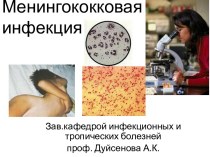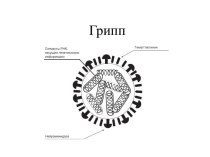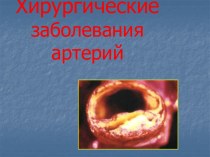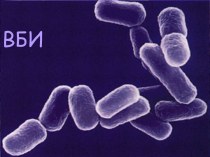- Главная
- Разное
- Бизнес и предпринимательство
- Образование
- Развлечения
- Государство
- Спорт
- Графика
- Культурология
- Еда и кулинария
- Лингвистика
- Религиоведение
- Черчение
- Физкультура
- ИЗО
- Психология
- Социология
- Английский язык
- Астрономия
- Алгебра
- Биология
- География
- Геометрия
- Детские презентации
- Информатика
- История
- Литература
- Маркетинг
- Математика
- Медицина
- Менеджмент
- Музыка
- МХК
- Немецкий язык
- ОБЖ
- Обществознание
- Окружающий мир
- Педагогика
- Русский язык
- Технология
- Физика
- Философия
- Химия
- Шаблоны, картинки для презентаций
- Экология
- Экономика
- Юриспруденция
Что такое findslide.org?
FindSlide.org - это сайт презентаций, докладов, шаблонов в формате PowerPoint.
Обратная связь
Email: Нажмите что бы посмотреть
Презентация на тему Microbiological diagnostics of anthrax, ricketsiosis and legionellosis
Содержание
- 2. Anthrax is an infection caused by the bacterium Bacillus
- 3. Bacillus anthracisfuchsin-methylene blue spore stainFermentation of
- 4. This was a blood agar culture plate
- 5. Rickettsiosis is a group of acute infectious
- 6. Rickettsia prowazekii appearance small Gram-negative short rods or coccobacillinonmotileobligate intracellular parasite
- 7. Infections caused by Rickettsia prowazekiiRickettsia prowazekii is the etiologic
- 8. Lab diagnostics1. Micro Immunofluorescence 2. ELISA
- 9. LEGIONELLOSISLegionellosis is an infectious disease caused by
- 10. Legionnaires' disease (also legionellosis or Legion fever) is a form of atypical
- 11. Скачать презентацию
- 12. Похожие презентации
Anthrax is an infection caused by the bacterium Bacillus anthracis. It can occur in four forms: skin, lungs, intestinal, and injection. Symptoms begin between one day and two months after the infection is contracted. The skin form presents with a
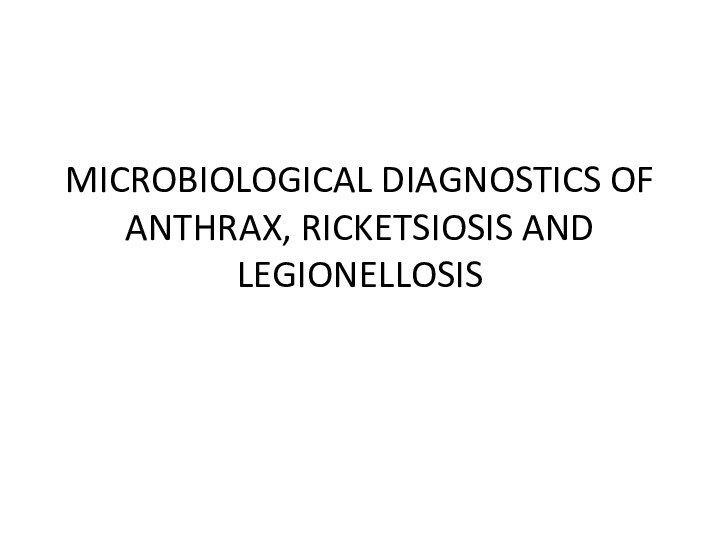
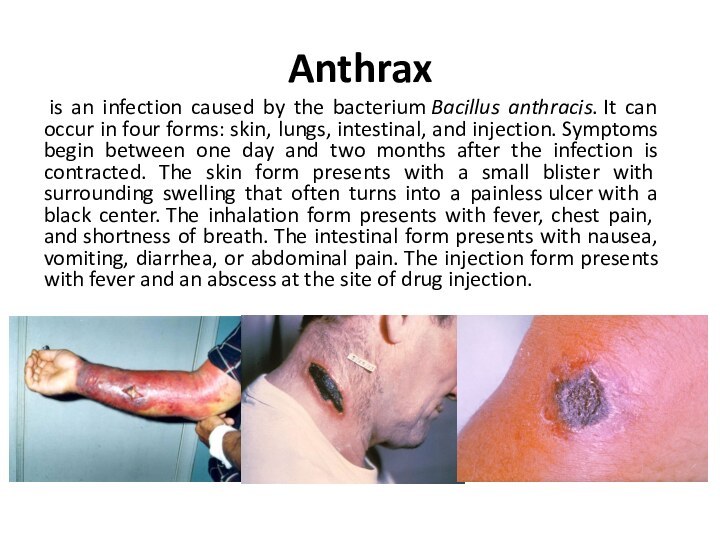






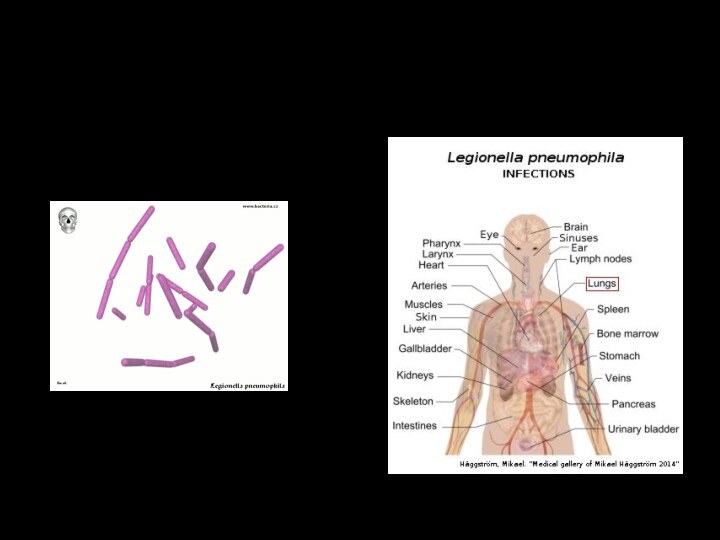

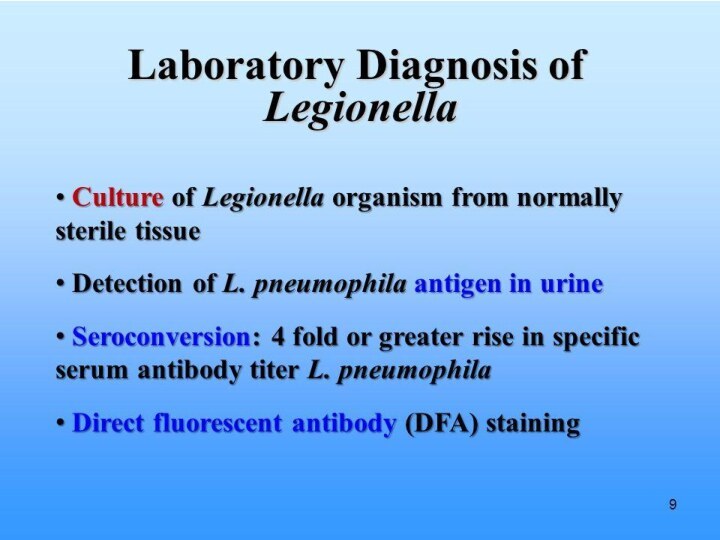
Слайд 4 This was a blood agar culture plate growing Bacillus
anthracis and other soil flora. This blood agar culture plate
grew representative colonies of B. anthracis and other normally occurring soil inhabitants.Слайд 5 Rickettsiosis is a group of acute infectious diseases
caused by intracellular parasites occupying an intermediate position between
bacteria and viruses; with a predominant transmission mechanism of transmission and characterized by generalized vasculitis and rash, occurring against a background of febrile-intoxication syndrome.RICKETSIOSIS
Rickettsia rickettsii (red dots)
in the cell of a deer tick
Слайд 6
Rickettsia prowazekii appearance
small Gram-negative short rods or coccobacilli
nonmotile
obligate intracellular parasite
Слайд 7
Infections caused by Rickettsia prowazekii
Rickettsia prowazekii is the etiologic agent
of epidemic typhus, transmitted in the feces of lice. Epidemic typhus
is a form of typhus so named because the disease often causes epidemics following wars and natural disasters. Typhus was also common in prisons (and in crowded conditions where lice spread easily), where it was known as Gaol fever or Jail fever.Symptoms include severe headache, a sustained high fever, cough, rash, severe muscle pain, chills, falling blood pressure, stupor, sensitivity to light and delirium. A rash begins on the chest about five days after the fever appears, and spreads to the trunk and extremities.
Epidemic typhus is found most frequently during times of war and deprivation. In the periods between outbreaks, when human to human transmission occurs less often, the flying squirrel serves as a zoonotic reservoir for the Rickettsia prowazekii bacterium. The mortality rate is 10% to 60%, but is vastly lower (close to zero) if intracellular antibiotics such as tetracycline are used before 8 days
Слайд 9
LEGIONELLOSIS
Legionellosis is an infectious disease caused by legionella
bacteria that multiply in air conditioning systems, showerheads, humidifiers,
inhalersthin, Gram-negative bacteria; Legionella stains poorly with Gram stain; may become filamentous in culture
motile (one polar flagellum)
non-encapsulated
non-spore-forming
Слайд 10 Legionnaires' disease (also legionellosis or Legion fever) is a form of atypical pneumonia caused
by any species of Gram-negative aerobic bacteria belonging to
the genus Legionella. Over 90% of cases of Legionnaires' disease are caused by Legionella pneumophila. L. pneumophila has only been found in aquatic systems, where it is symbiotically present in aquatic-borne amoebae. It thrives in temperatures between 25 and 45°C , with an optimum temperature of 35°C. During infection, the bacterium invades macrophages and lung epithelial cells and replicates intracellularly. Legionnaires' disease is transmitted by inhalation of aerosolized water. It is not airborne and it is not transmitted from person to person. Sources where temperatures allow the bacteria to thrive include hot-water tanks, cooling towers, and evaporative condensers of large air-conditioning systems, such as those commonly found in hotels and large office buildingsL. pneumophila (red chains) multiplying inside Tetrahymena pyriformis
In humans, L. pneumophila invades and replicates inside macrophages. The internalization of the bacteria can be enhanced by the presence of antibody and complement, but is not absolutely required. Internalization of the bacteria appears to occur through phagocytosis.






